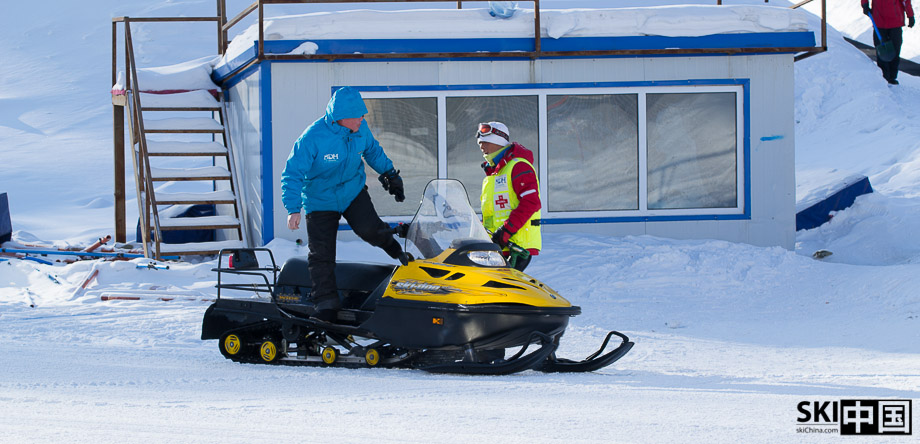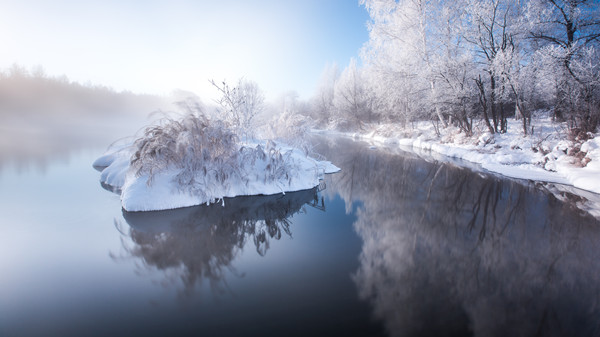This blog post was made by user 北京卡宾 (Beijing KaBin) and offers some interesting thoughts as to the motivations behind ski trips in China, as well as a brief insight into the difference between the knowledge of different winter sports available worldwide versus those currently available in China. Afterwards, the blogger posts a guide to buying skis, demonstrating a good depth of knowledge.
Turning – Why do we ski? 《转》我们为什么滑雪
From <http://bbs.8264.com/thread-2188236-1-1.html>
Skiing can be considered as one of the four gentlemanly sports (skiing, tennis, equestrianism, golf). As winter draws close it represents the best method to get active while remaining close to nature. Speed, strength, courage, style are essential on the hill, but the most important consideration is to get out there and take part for yourself! On winter weekends, separated from the grim dirt and grime of our polluted urban metropolises and surrounded by a world of gleaming silver and white hills, the natural joy of skiing is becoming an ever more popular choice. Skiing generates powerful emotions amongst its participants that cannot be matched by other sports, and skiers quickly become overcome by the feelings.
The quality of equipment in China’s domestic ski resorts is generally rather poor and old, leading to a dulled enjoyment of the activity and a decline in the rate of skill progression. Shared rental boots are often not thoroughly cleaned and dried, which isn’t ideal for personal hygiene and could even potentially lead to a case of athlete’s foot! Spending time collecting your equipment on each ski trip also shortens your time on the hill, and can be disruptive to your performance. Following a typical rate progression, many snowsports fanatics end up with their own equipment. Choosing and buying your own equipment isn’t a difficult process, and the most crucial part is selecting appropriate kit for your ability. 13000RMB’s (€1700 / $2100 / £1400) worth of performance skis will flex like they’re made of solid iron, whereas you might be better able to perform solid turns on cheaper 4000 RMB (€500 / $650 / £410) models.
According to the wisdom of today’s beginner snowsports fans, no matter whether your preference is for snowboarding or alpine skiing, using the right equipment is one of the most important aspects. One recent beginner let me know that with so many different brands and types of equipment on offer, learning how to pick equipment that will bring him pleasure and happiness is a serious matter! Entering a ski shop and seeing all the beautiful pieces of skis for sale and deciding what to buy can be a fun process. But faced with so many choices of length, turn radii, width, flex and stiffness, most people will find it difficult to decide what is right for them.
The first job is to decide what one wants to get from skiing, which will give the whole process a sense of direction. In short, do you just want to mess around? Do you want to progress to competitions as fast as possible? Do you want to feel the mountain underneath you, and to take on the most extreme slopes? Maybe all you really want to do is make some gentle turns and just enjoy taking in the silver white surroundings.
The Chinese domestic skiing season is not long, restricted by the climate and regional conditions, and the Chinese resorts lag somewhat behind European, American, Korean and Japanese offerings. Opportunities for domestic off-piste powder and freestyle skiing are limited. Most of the snow is machine made, and many resorts cannot guarantee their snow conditions on a daily basis. The rare half pipes and cross country trails that do exist are generally restricted for the use of specialists and professional teams. Many of the developments in progress have ended up stunted, and many skiing disciplines, including freestyle and Euro style Nordic, currently have no real home in China.
The most suitable equipment for Chinese pistes are standard Alpine Carvers. The vast majority of skis that you’ll find for sale in China are of this type.
- There is a link between length of ski and attainable speed. A simplified explanation is that, for an equal skier weight and power, on an equal steepness of slope, longer skis allow you to ski faster, and shorter skis will be slower.
- The is an inverse link between length of ski and control of the ski. Again, simply put, in identical surroundings, the longer the ski the harder it will be to control, with a wider turn radius and less sensitivity to input. Once again, the opposite is true. To summarise – long skis are fast, short skis are nimble.
- The skis’ length and their turning ratio are inversely proportional. Generally you can buy each ski in different lengths. If a ski is available in 159cm, and this particular model continues in 7cm increments, then you’ll be able to choose from 152, 159, 166, 177 versions. The longer the length, the longer the turn radius.
- There are three vital measurements on a ski, (width of tip, waist and tail, generally in mm), and these also relate to the turning performance. Skis with big differences between these three measurements generally give short radius turns, those with small differences generally give large radius turns. Before the year 2000, skis tended to be very straight and narrow, and the turning radius was over 20m. Nowadays, a typical ski features a tip width of 115-120mm, a waist of 70mm and tail of 100-105mm. A narrow waist width that is easy to put on its edge is called a ‘Carver’. World Cup FIS Race skis feature even narrower waists, right down to 67mm. Wide waisted skis offer good stability, can be skied aggressively and are suitable for the vast majority of skiers.
- The thickness and angle of the skis’ metal edges is important. Standard production skis generally come with thick edges, with the aim of durability. The aim of race skis is winning races, even at the cost of a lifespan of just a few races, so race ski edges come thinner. As this is somewhat of a controversial point, we ran a test at one of our friend’s ski shops, trying to tell two pairs of skis apart with the naked eye. Standard production skis generally come with an 89º edge angle; race skis use 87-87.5º to enable their specially trained owners to make more inclined turns.
Wood-core and production technology. The earliest skis were made of wood, but wood is easily affected by cold and damp, meaning that the wood fibres can easily become brittle and snap. The main effect of the wood core is a throwback to the past, with each brand label’s specific core construction amplifying the difficulty of construction. The greatest effect on the final skis’ performance depends on the compounds of high polymer materials and metals layered together. Just like today’s cars, the importance of putting wood in the middle is to give them some old-style aesthetic value. The manipulation of skis involves the laminating two materials and pressing them together in a mould. After Atomic abandoned their Beat X mode, today’s lamination technology has been adopted by everyone.
《转》我们为什么滑雪
滑雪被称为是绅士运动之一(滑雪、网球、马术、高尔夫),是冬天最为靠近大自然的一种运动休闲方法。速度、力气、勇气、窍门融于一体,但最重要的精力一直是自傲与参加。冬天周末,脱离烟尘污染严峻的都市,在群山环绕的银色世界中潇洒的滑行是许多时髦人士挑选。滑雪者在滑雪运动中将感触激烈的、其它旅游项目所无法比拟的成功感、降服感和影响感。
国内雪场的租借雪板通常层次较低、年代久远,滑雪感触很差,不利于滑雪技术的进步。共用的租借雪鞋,不能及时的消毒和烘干,十分不利于自个卫生,乃至会致使脚气的感染。每次滑雪都有一个雪板习惯的进程,缩短了有用滑雪时刻,并且不利于自个滑雪根本动作的标准。跟着滑雪运动的平民化进程加速,一些滑雪发烧友想到了自个采购滑雪板。其实选购滑雪板并不是一件难事,最最要害的即是要挑选合适自个的。13000多元的竞技雪板感触像踩铸铁板,4000RMB的套装雪板立刃流通即是这个道理。
可是关于如今的初级滑雪者爱好者来说,无论是单板(Snowboard)仍是高山滑雪(Alpine ski),运动的快感与美丽的配备相同重要乃至更重要。关于一个初级滑雪爱好者来说,怎么从许多品牌及类型的滑雪板中挑选出能够给合适自个,并带来无穷乐趣的一套滑雪板真是个很要害的疑问。进入滑雪器件店,看到琳琅满意图滑雪器件,感触哪一个都很吸引人。可是面临比如种类、长度、转弯半径、三围尺度、弹性、硬度等等各种数据,多数人都会莫衷一是。
首先要断定自个滑雪的意图,这就处理了方向性疑问。简略的说即是我想要玩啥?玩竞技寻求最快的速度?仍是灵敏的顺山而下、降服最极限的斜度?或许即是随心而欲的反转,享用在银色世界滑行的感触。
国内的冬天滑雪运动展开时刻不长,受气候和地域的约束颇多,滑雪场的建造比照欧美、日韩等要落后一些。国内玩粉状雪(野雪)、自由式的场所很少,大多都是机压雪道,许多雪场不能确保每天都进行雪道平坦。单个的U槽道、越野道仅仅比照赛和专业运动队敞开,许多项目展开受限,许多类型的雪板在国内没有用武之地,如FREESKI自由式、Nordic越野滑雪、北欧2项无法在国内遍及。
那么在国内比照合适的即是高山Alpine ski 滑雪板。在国内滑雪店里零售的也大都是这个类型的板子。
1、板长和速度成正比,简略的解说即是在平等分量下、平等斜度下,雪板长度越长的下滑速度越快,反之亦然。
2、板长和可控性成反比,简略的解说即是在平等环境下比照,越长的板子越欠好操控,转弯半径大,不灵敏,反之亦然。即是长板快、短板灵。
3、板长和转弯半径成正比,通常一个品牌同一个系列的板子有不一样的长度,如基准长度为159、进制为7CM的雪板,会有152、159、166、173等几种长度能够挑选,那么即是越长的板子转弯半径越大。
4、三围尺度(板头、板腰、板尾的宽度,单位毫米mm)和转弯半径的联系,三围尺度改动大的板子通常转弯半径小,三围改动小的转弯半径大。如2000年曾经的直板,三围改动很小,转弯半径要20多米。如今盛行的板型三围,板头115-120mm,板腰70mm,板尾100-105mm。板腰窄的板子易于走刃刻滑Carver,FIS Race世界雪联认证的参赛板,板腰很少有超越67mm的。板腰宽的板子稳定性好、经过性强、易于转弯合适大多数滑雪发烧友运用。
5、雪板边刃的厚度和视点,民用量产雪板的边刃比照厚,这个类型的板子考究的是寿数,Race的板子寻求的是成果,乃至一幅板子的运用寿数即是几场竞赛,Race的板子的边刃也相对要薄一些,这个疑问有贰言的话,我们去磁器口雪具店验证一下,2付雪板立在面前,用肉眼就能看出来的不同。别的民用量产雪板的边刃视点是89度左右,Race的板子是87-87.5度,由于专业运动员的侧身视点很大。
6、木芯和生产技术。最早的雪板是木材做的,可是木材由于简单受潮后物理性能改动,木质纤维在重复拉伸后简单变脆折断,木芯的效果首要即是复古了,单个牌子标称的木芯反而增大了加工难度和本钱。雪板的首要物理性能是取决于复合高分子材料和金属夹层。就像如今的轿车,木材在里面的首要效果是仿古贴皮漂亮。雪板加工技术首要是2种,层压和模压,atomic抛弃了Beat X平台后如今层压技术根本上统一天下了。




